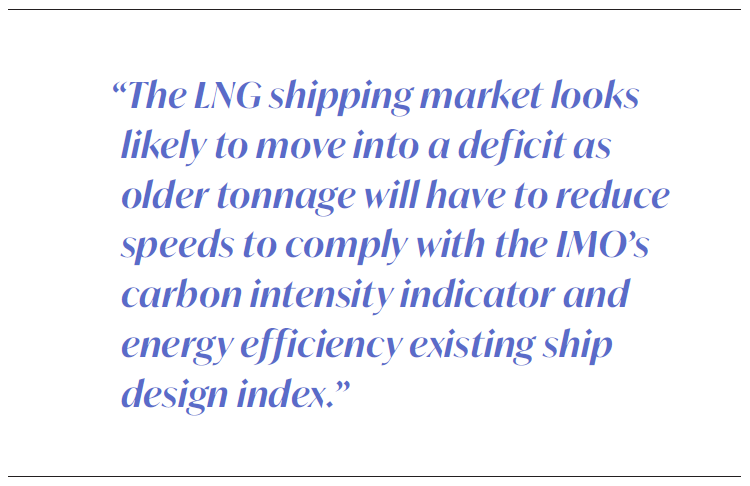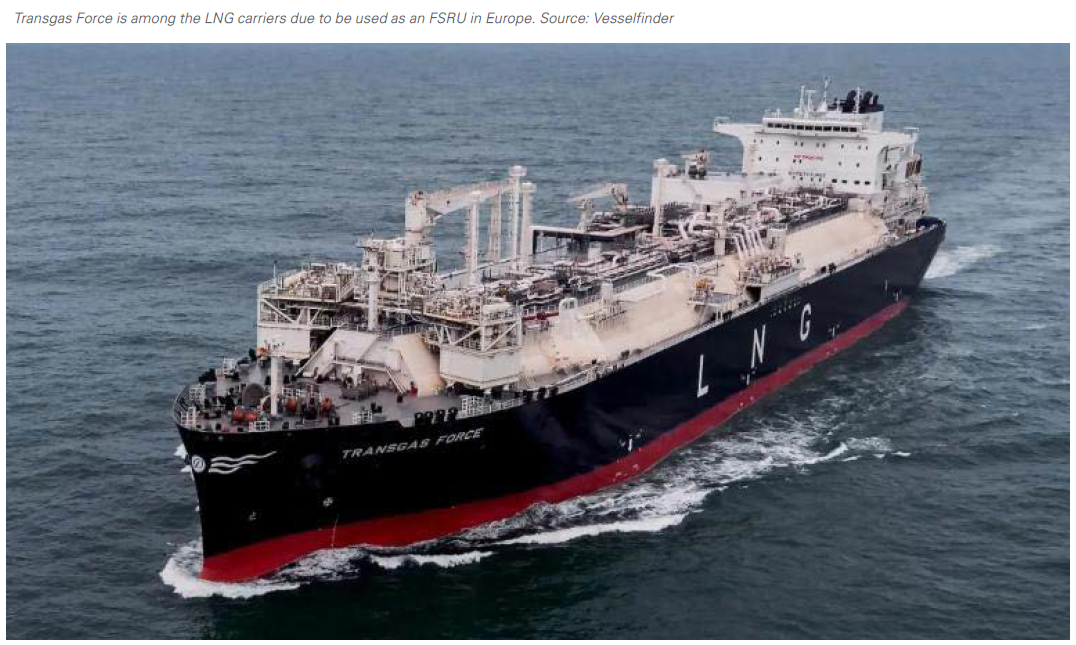LNG carrier market tightens amid heated competition for supplies [Gas in Transition]
Competition between Europe and Asia for limited LNG supplies is set to keep supply and demand in the global market for the fuel finely poised this year, but an overlooked factor that could tighten balances even further is constrained vessel availability after new international regulations on shipping emissions took effect.
Shell’s latest LNG Outlook released in mid-February laid out a five-year future in which a “structural gap” in European gas supplies will drive LNG as a “core energy supply source” for the continent. The global configuration of the LNG market will shift as a consequence, with Europe moving from a role of peripheral buyer – or so-called “balancing market” – to a premium market. This is expected to remain the case going forward.
At the same time Asian demand looks set to return this year, supported mainly by recovering demand in post-pandemic China. The country’s LNG imports fell by 15mn metric tons or 19% year-on-year in 2022, marking the first annual decline since 2015 when they fell by 1%.
The global LNG market has tightened significantly over the past year from the drop in Russian pipeline gas flows, which prompted unprecedented policy and regulatory intervention as governments in European capitals sought to bolster energy security and shield economies from high costs.
But this structural shortfall will be worsened by new CO2 emissions requirements for shipping introduced by the International Maritime Organization (IMO) that came into effect at the start of this year. These will restrict sailing speeds for vessels that use steam turbine and dual or tri-fuel diesel-electric engines due to their higher boil-off gas (BOG) rates compared with newer ships.
As these three engine types power more than half of the global fleet, slower speeds will reduce the number of journeys that vessels will be able to make – leading to higher freight rates that are already sky-high after last year’s energy market disruptions. Charter rates for steam turbine vessels reached $200,000/day towards the end of last year while daily costs for dual or tri-fuel diesel-electric ships climbed to $350,000-400,000.
LNG carrier availability already declined in 2022 after at least nine vessels exited the fleet to serve as floating storage and regasification (FSRU) terminals. Most recently the Transgas Force and Transgas Power carriers – each with a capacity of 173,000m³ and owned by NYSE-listed Dynagas LNG Partners – stopped delivering shipments towards the end of last year in preparation for deployment as FSRUs in Germany.
Germany, Europe’s biggest importer of Russian pipeline gas before the Ukraine war, intends to deploy at least six FSRUs across a minimum of four locations by the end of this year. FSRUs are also set to come online in Finland, France, Italy and possibly Albania and Cyprus.
Shipping analysts expect a tighter balance this year. Preliminary forecasts from energy consultancies have tipped global LNG exports to grow by 16mn mt/yr to bring total traded volumes to 412mn mt. At the same time global LNG carrier capacity will edge up by just 2.5mn mt/yr to 426mn mt/yr, leaving a 3% surplus or approximately 20 vessels.
New IMO regulations
But the LNG shipping market looks likely to move into a deficit as older tonnage will have to reduce speeds to comply with the IMO’s carbon intensity indicator (CII) and energy efficiency existing ship design index (EEXI) that were introduced on 1 January.
The EEXI and CII are the most important of several amendments adopted by the IMO in June 2021 to reduce the shipping sector’s greenhouse gas emissions. The IMO is targeting a 40% reduction in the carbon intensity of the global fleet by 2030 compared with 2008 levels, rising to 70% by 2050.
The EEXI is a one-off certification that applies to all ships built before this year and determines a vessel’s standardised CO2 emissions based on its tonnage and speed. Each ship will be given its own EEXI according to a formula defined by the IMO that accounts for different factors depending on the vessel type.
For LNG carriers the formula considers BOG and the additional auxiliary power needed for the reliquefaction system. Vessels that fail to meet the emission requirements will have to take action to achieve compliance, such as optimising propulsion systems, reducing shaft power, using alternative fuels or deploying energy-efficiency technologies.
For LNG carriers with a deadweight tonnage exceeding 10,000, EEXI implies a 30% reduction in their CO2 emissions/mt-mile relative to a baseline representing the average efficiency for ships built between 2000 and 2010.
The CII meanwhile considers how much CO2 is emitted by a vessel per deadweight-mile. Vessels will be given an annual energy efficiency rating ranging from the highest rating of A to the lowest of E, with C being the minimum required rating.
Any vessel rated D or E for three consecutive years will have to submit an action plan that outlines how they will achieve the minimum C rating. For this year LNG carriers must reduce their emissions by 5% compared with 2019 levels, but this will become gradually tightened – tankers must emit 11% less CO2 by 2026 than they did in 2019.
Staying compliant
The most economical way for older tonnage to comply with the new regulations is to reduce engine power, which will in turn lower travelling speeds. Reducing the maximum sailing speeds of steam turbine and dual or tri-fuel diesel-electric vessels from 19 knots to 15 would be equivalent to removing the capacity of 21 vessels, assuming that the lower speed is maintained for 30% of the voyage.
This would be enough to shift this year’s LNG shipping market into a 1mn mt/yr capacity shortfall, leaving freight balances extremely tight. There is additional downside risk if more LNG carriers in the fleet are repurposed as FSRUs this year.
The degree of implementation will mostly determine the impact of the EEXI and CII on shipping fundamentals. The IMO has not clearly spelled out penalties for non-compliance but when it comes to the EEXI, ports authorities could start requesting evidence of compliance starting from this month and deny entry to any vessels without a valid certificate.
It is not clear if a carrier with a D or E rating under the CII will have to stop sailing until a corrective action plan has been achieved. But high compliance with both regulations is likely – most banks and lenders already have strict requirements on engine-efficiency specifications as well as a carrier’s ability to comply with emissions regulations.
Compliance with IMO regulations will likely be established as a key condition for access to financing. This means that going forward charterers will be increasingly reluctant to hire vessels that do not meet EEXI and CII standards.
Older tonnage most exposed
There are an estimated 630 active LNG carriers in the global fleet, excluding floating facilities and LNG bunkering vessels. Among these are 222 steam turbine vessels and another 175 tankers using dual or tri-fuel diesel-electric propulsion. Those three categories of vessels burn BOG from cargo tanks and fuel oil, with steam turbine carriers having a daily boil-off rate of around 0.15%, while dual or tri-fuel diesel-electric vessels are slightly more efficient with an average daily boil-off rate of 0.1% on average.
But their lower efficiency overall means steam turbine and dual or tri-fuel diesel-electric carriers are less competitive than vessels with newer propulsion systems when it comes to EEXI and CII compliance.
While limiting engine power output is the most economical way for shipowners with older tonnage to comply with the new regulations, there are alternative options too. Shipowners could install energy-efficiency technologies, such as steam-to-hybrid conversion design, but retrofitting a vessel comes at a significant cost and the payback period may not last long given that regulations will become increasingly stringent over time.
With slots at LNG shipyards in South Korea and China fully booked until 2026 and the construction time for an LNG carrier newbuild averaging around three years, relief for shipping balances will only come in 2024-2026, with a wave of vessels set to be delivered during that period – mostly on the back of large orders from QatarEnergy to accommodate the 49mn mt/yr North Field Expansion.
Some 186 newbuilds are set to be completed in 2024-2026, but the majority of these vessels will enter the fleet with long-term charters attached – only 32 ships are currently uncommitted on the orderbook, suggesting that prompt LNG carrier availability will remain low in the medium term.
The capacity shortfall is looming just as the global LNG market is poised for another year of limited supply additions. Only two projects are scheduled to come online this year, namely the Tangguh LNG Train 3 expansion in Indonesia that will add 3.8mn mt/yr and the 2.3mn mt/yr Greater Tortue Ahmeyim floating LNG (FLNG) operation off the coasts of Mauritania and Senegal. Both projects, led by BP, will take time to ramp up – especially for the latter based on Shell’s experience with its Prelude FLNG facility offshore Australia.



